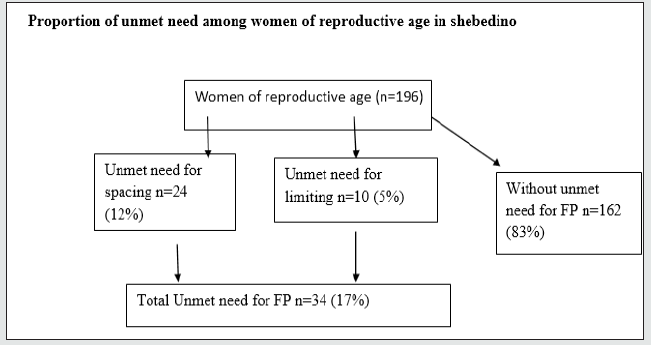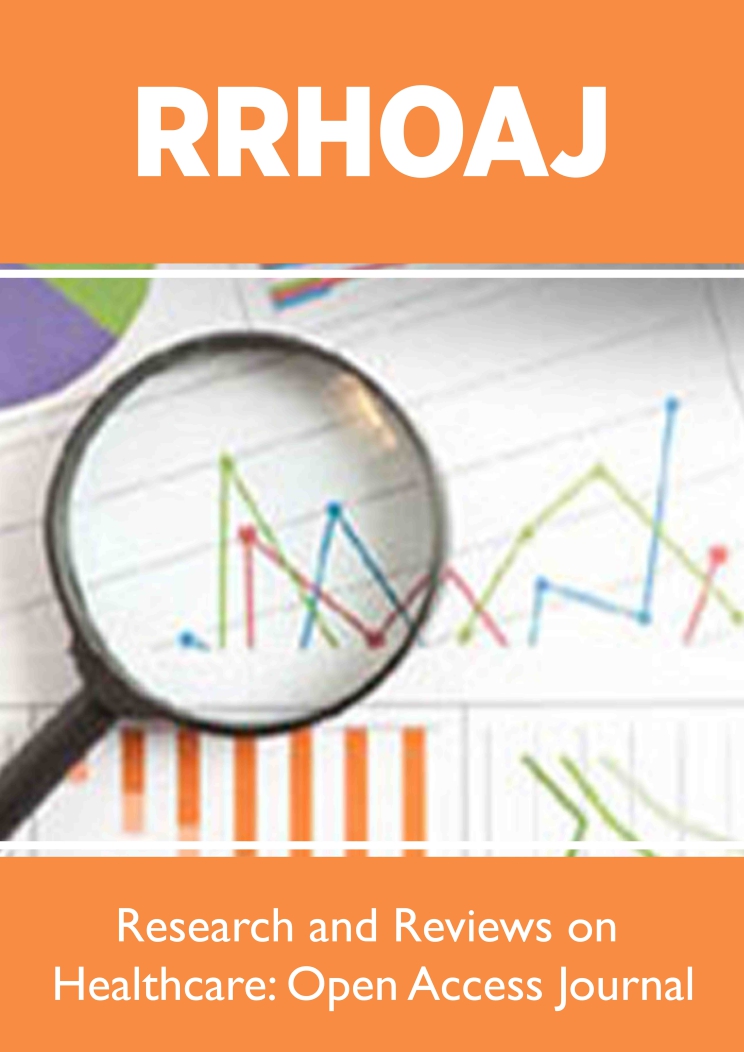
Lupine Publishers Group
Lupine Publishers
Menu
ISSN: 2637-6679
Research Article(ISSN: 2637-6679) 
Unmet Need for Family Planning Among Women of Reproductive Age Living in Shebedeno Volume 6 - Issue 4
Kaleab Tesfaye Tegegne1*, Yohannes Kifle2, Teshale Belayneh3, Eleni Tesfaye Tegegne4 and Mekibib Kassa Tessema5
- 1Department Of Public Health, Hawassa College of Health Science, Hawassa, Ethiopia
- 2Department Of Public Health, Hawassa College of Health Science, Hawassa, Ethiopia
- 3Department Of Public Health, Hawassa College of Health Science, Hawassa, Ethiopia
- 4College Of Medicine and Health Science, School of Nursing, University of Gondar, Gondar, Ethiopia
- 5Leishmania Research and Treatment Center, University of Gondar, Gondar, Ethiopia
Received:June 22, 2021 Published:July 06, 2021
Corresponding author:Kaleab Tesfaye Tegegne, Department Of Public Health, Hawassa College of Health Science, Hawassa, Ethiopia
DOI: 10.32474/RRHOAJ.2021.06.000241
Abstract
Background: Throughout the whole world, the unmet need for family planning data has become a very useful tool in measuring and predicting the contraceptive needs of a population. Access to family planning services and awareness has improved greatly, but the unmet need for family planning continues to remain high.
Objective: To assess unmet needs for family planning and the factors responsible for this unmet need for family planning among women of reproductive age in shebedino.
Methods: A community-based cross sectional household survey was conducted. And pretested questionnaires were administered for 196 women of reproductive age in shebedino from June; to July 2019. All research group members were undertaken data collection .216women of reproductive age in shebedino were selected by systematic random sampling technique and the data was collected from house to house . The data were entered and cleaned in SPSS version 20 for analysis. Multivariate Logistic regression was used identify factors associated with unmet needs for family planning.
Result: The Westoff model revealed that the total unmet need for family planning was 17%; 12% for birth spacing and 5% for birth limiting. Multivariate regression revealed that the unmet need was significantly associated with age, region of residence, experience of child loss, education level, partner’s education level and knowledge level on contraceptives (p < 0.05).
Conclusion: The unmet need for family planning was still quite high among the respondents and associated with various determinants that should be considered while planning for scaling-up healthcare program. To address this current high level of unmet need for family planning in urban regions, the government should focus on promoting level of education beyond primary level, improve maternal and child healthcare, and adopt region and age specific programmatic actions in order to reduce unmet need to an acceptable level.
Keywords: Unmet Need for Family Planning; associated factors of unmet need for family planning.
List of Acronyms And Abbreviation: CBD: Community-based Distributor; CI: Confidence Interval; CPR: Contraceptive Prevalence Rate; DHS: Demographic and Health Survey; FP: Family Planning; GOK: Government of Kenya; IEC: Information, Education and Communication; IPDC: International Population and Development Conference; LAM: Lactational Amenorrhoea Method; MDG: Millennium Development Goal MNCH: Mother and Child Health; OR: Odds Ratio; PMTCT: Prevention of Mother to Child Transmission RH: Reproductive Health; SPSS: Statistical Packages for Social Sciences UN: United Nations; UNFPA: United Nations Population Fund WFS: World Fertility Survey; WHO: World Health organization.
Introduction
Background: Women who want to postpone their next birth for two or more years or who want to stop childbearing altogether but are not using a contraceptive method are considered to have an unmet need for family planning. Pregnant women are considered to have an unmet need for family planning if their pregnancy was mistimed or unwanted. Similarly, amenorrhoeic women who are not using family planning and whose last birth was mistimed or unwanted have an unmet need. Women who are currently using a family planning method are said to have a met need for family planning. [1-5]. Throughout the whole world, there has been a progress in the access to family planning services and products, but the unmet needs for family planning continue to remain high. In the developing countries the number of individuals wishing to use family planning supplies and services but do not have access to modern contraceptives still remain high [5-7]. Limited attention has been paid to determine the causes of the unmet need for family planning especially among low income urban residents, despite family planning being an important issue in public health policy for women in the entire population [8].
Statement of the problem: An estimated 150 million women worldwide want to delay or avoid pregnancy but at the same time are not using family planning methods. The lack of usage of family planning among married women is attributed to lack of knowledge, socio-economical problem, fear of side effects, religious cause, insufficiency of FP services, uncooperative husband and limited supply and high cost [9,10]. Despite all these problems, no study has been documented that investigate the proportions of unmet need for FP among women living in shebedino to date. Lack of this essential periodical indicator on unmet need for FP becomes a great challenge to policy formulators and implementers in designing, monitoring and evaluation of FP programs.
Significance of the Study: The unmet need for FP was added as an indicator for monitoring maternal health progress. In this study, the determinants and proportions of unmet need of family planning among reproductive age women of shebedino was assessed with the aim of informing health service for interventions. unmet need proportion is an important indicator for national FP programmes because it helps in monitoring and evaluations of practiced strategies thus serves as an evaluation tool. Furthermore, if the need for family planning is met, the associated harmful risks of unwanted pregnancies such as maternal death and unsafe abortion can be prevented, and the family health will be improved. It is estimated that the lives of more than 150,000women will be saved with access to sufficient family planning each year worldwide. With the study results, awareness can be raised and family planning efforts can be reinforced to address unrealistic view of risk and promote uptake of family planning services. This will reduce the number of unwanted pregnancies, number of abortions and the proportion of births at high risks among women all over the country and specifically those living in shebedino[11-15].
Methods and Materials
Study Area: The number of women in reproductive age group in shebediono is 286,000. The study Was conducted from June–July 2019.
Study design and period: Community cross-sectional study design was conducted from June –July 2019.
Source population: All women of the reproductive age (15-49 years) in shebedino.
Study population: Women of the reproductive age (15-49 years) who are selected by systematic random sampling technique and meet inclusion criteria.
Inclusion criteria: Women of reproductive age (15-49yrs) who are married or in union, sexually active, fecund those who consented and residents of shebedino.
Exclusion criteria: Women who never had sex, non residents, unmarried/not in union, declared infecund, and sterilized.
Study Variables
Dependent variable: Unmet need for family planning.
Independent Variables: Demographic variables (age of women, age at marriage/union, number of living sons, child loss experience and number of living children), Socio-economic factors (household economic status, women’s education, husbands’ education status, work status and region of residence), and cultural variables (Religion ). Knowledge on contraceptive methods was also included in the analysis to assess its effect on unmet need proportion.
Sample Size Determination and Sampling Procedure:
The sample size was determined using the formula below for a population greater than 10,000 (Kothari, 2004) Single population proportion formula was used to calculate a sample size, by using 15 % expected magnitude of unmet need for family planning (Unmet Need for Family Planning and Associated Factors among Currently Married Women in Misha District, Southern Ethiopia: A Cross Sectional Study) 10% Non-response rate were considered.
N = Z2 pq/d2
Where z=1.96(at 95%confidnce interval).
P=23..4%% (prevalence of early discontinuation of implant).
q=1-0.234=0.766.
d=0.05 degree of accuracy or margin of error.
Hence Ni = Z2 pq/d2
Ni= (1.96)2(0.15) (0.85)/ (0.05)2 =196
Thus, by adding 10% none response rate, the final sample size was 216 women in reproductive age group living in shebedino were selected by systematic random sampling technique.
Data collection procedure: A structured and pre- tested interview based questionnaire with both open ended and closed ended questions was used to collect the data. questionnaires include questions that derived to the unmet need for family planning proportions, the reasons for the unmet need, knowledge on contraceptives and other vital information such as age, occupation, number of children among others to support the study. the questionnaire was adopted from reviewing different literatures and scientific facts. Questionnaire was first prepared in English and translated to sidamegna by local language speaker to make it understandable by the study participants and to check whether the translation was consistent with the English version. The questionnaire was back retranslated to English by another person[16-19].
Data Quality control: All Group members of research were undertake data collection. Before the actual data collection, the questionnaire was pretested in 5 %( 11 women) outside of shebedino. Based on the pretest, necessary modification were made on the questions and the data of the pretest were excluded in the actual data analysis. The data was collected by selecting households using systematic sampling The data collectors were checking for completeness and consistency before leaving the interviewee. The study participants was asked after the data collectors explained the purpose of the study and obtaining verbal consent from each respondent.
Data processing and analysis: After the data collection have finished, the data was entered and cleaned in SPSS version 20. The data was presented in tables and figures.. Then, bivariate and multivariate analyses was done for the independent variables with the outcome variable (early implant discontinuation).
Operational Definitions
a) Modern Family Planning: refers to a program which enables couples and individuals to decide freely and responsibly the number and spacing of their children and to have the information and means to do so, and to have informed choice and access to a full range of safe and effective modern methods of preventing pregnancy.
b) Unmet need for family planning: is referring to those women who prefer to space or limit childbearing, but she is not using any effective modern contraceptive to fulfill its desire.
c) Fecund: a woman of reproductive age who is not pregnant at the moment but is capable of childbearing.
d) Infecund: a woman of reproductive age who had never been pregnant for at least five years of trying to conceive a baby.
Ethical consideration: Ethical clearance was obtained from research and ethical committee (REC) of Hawassa College of Health Science , Department of Public Health . Permission for conducting the study were obtained from the Hawassa Health Bureau.
Then official letter was written to each kebele administration . Information sheet that contains about the benefit and risk of participating of the respondents in this study with verbal informed consent was attached to each questionnaire to brief and obtain each study participant.
Result: Socio demographic characteristics the response rate was 90% out of 216 women only 196 women interviewed Out of 196 respondents, majority of the sampled respondents were in the 25-34 years age bracket with 56.1% (n=110) with only 28.6% (n=56) were in the age bracket of 15-24 years and 15.3% (n=30) was in the age bracket of 35-49 years. About 47.4% (n=93) got married at an age bracket of 25 and above with majority 52.6% (n=103) got married/union at an age bracket of 15-24.More than half of the respondents 80.1% (n=157) had 0-2 living children and only 19.9% (n=39) had more than 3 children. Nearly 88.8% had between 0-2 living sons while the rest 11.2% (n=17) had more than two living sons. Only 13.3% (n=26) of the respondents had experienced child loss or death while the rest 86.7% (n=170) had never experienced any as shown in Table 1. Twenty seven percent (n=53) of the respondents had no basic education, 45.4% (n=89) had only primary education, while 52.6% (n=103) had secondary education and above. About, 52.6% (n=103) of the respondent’s husbands had achieved secondary education and above, followed by those who said that their husbands had only primary education at 37.2% (n=73) and a small number, 10.2% (n=20) of respondents had partners who had no formal education. Most of the respondents were unemployed represented by 46.4% (n=91) while 17.9% (n=35) were employed. However, 35.6% (n=70) were operating their own businesses Out of the 196 respondents, 24 respondents representing 12% had total unmet need for spacing pregnancy while 10 respondents representing 5% had unmet need for limiting child bearing as shown in Figure 1 above. The total unmet need rate was therefore 17% (n=34).
Table 1: Socio-Demographic Characteristics of Women of Reproductive Age living in shebedino , June 2019 (N=196).
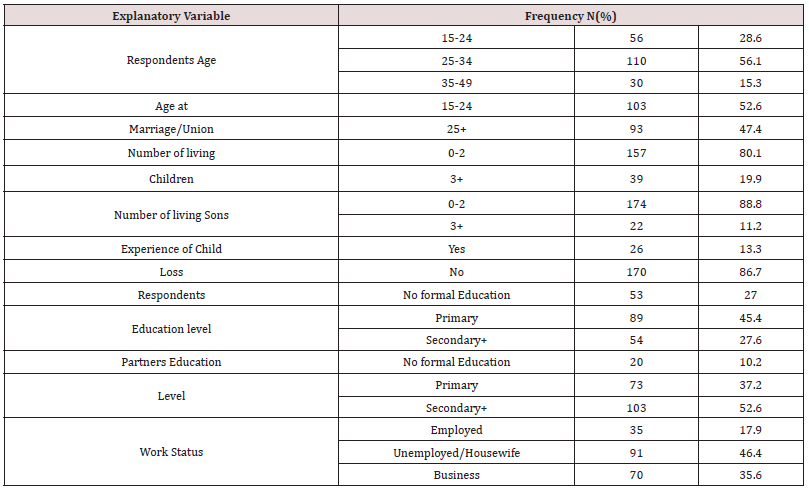
Figure 1: Conceptual Framework showing the relationship between independent variables and the Unmet Need for family planning (Kaushik, 1999).
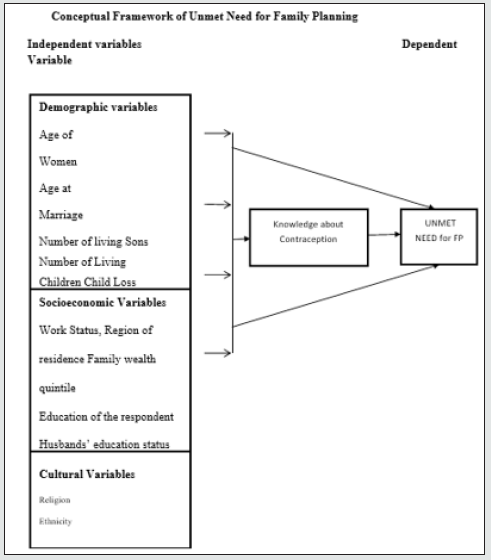
Determinants of Unmet Need for FP among Women of Reproductive age living in shebedino: In the study, various explanatory variables were subjected to a regression model to determine whether they have any significant association with the dependent variable, unmet need for FP.
Demographic determinants of unmet need for FP among women living in shebedino: Table 2 shows the distribution of the unmet needs according to the demographic variables in the study. Amongst them, a total of 17 respondents were in the age group of 15 to 24 years, while for the age group of 35years and above had only 8 respondents with unmet need for FP. The model results indicate that women’s age shows a strong relationship and likelihood of having unmet need (P=0.008). It is about two and half more likely for women with ages above 35years to have unmet needs as compared to those in the ages 15-24 years (OR=2.556). However, women in the ages 20-34 years had about 37% chance of meeting their FP needs compared to those aged 15-24 years (OR=0.063). This implies that older women have more unmet need which might be attributed to lack of contraceptive uptake for limiting birth among this age group. Young women (15-24 years) do have unmet need probably due to lack of knowledge on contraceptives. The study also indicates a strong significant relationship between child loss and unmet need for FP (p=0.026). Women who have an experience of child death have a high rate of unmet need for family planning; 53.8% (n=14) of the respondents with the unmet need for FP had experienced child loss while 11.8% (n=20) had no experience of child loss. The study indicates that there was less likelihood of women who have not experienced child loss to have unmet need (OR=0.103). It is believed that when a child in a family dies, a woman becomes more anxious to replace the dead one leading to reluctance in taking contraceptives. This implies that proper health services geared towards child survival is essential in-order to increase the uptake of FP services. From the study model, age at marriage/union, number of living sons and number of living children, were not associated with total unmet needs for family planning. However, it can be seen that the unmet need of FP likeliness increases as the number of living children increases and reduces when the number of living sons and age at marriage/union increases as compared to the reference category Figure 2.
Table 2: Demographic Determinants of Unmet Need for family Planning among women living in shebedino (n=196).
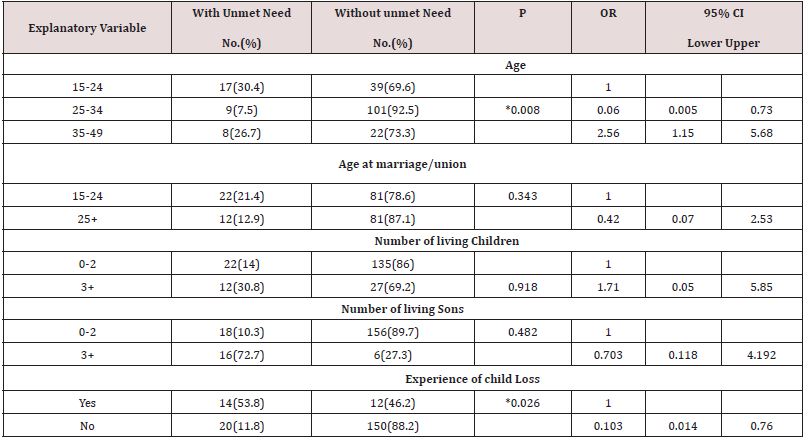
P-significant value; OR- odds Ratio; CI-Confidence interval.
* Significant P values.
Socio-Economic determinants of unmet need for FP among women living in shebedino: Table 3 shows the distribution of the unmet needs according to the socioeconomic variables in the study in the multivariate model, it showed that unmet need for FP was positively associated with the level of education of the respondents (p< 0.05). Women who attained secondary education and above had less likelihood of having unmet need for FP (OR=0.06) while those who attained primary education level (OR=0.25) as compared to those respondents with no formal education[20-23]. This implies that the higher the education attained, the likeliness of meeting the FP needs increases. The possible explanation for this could be that women empowered through education have good knowledge on contraceptives and have better access to health facilities compared to uneducated women. In this study, partner’s education level was significantly associated with the unmet need for FP (p= 0.007).The result indicates that the higher the level of education of the partner, the less the likelihood that a respondent would report unmet need for FP. Specifically partners having more than secondary education increased the chance of met need for FP by 99.5% while primary education increased the chance by 92.5% among the respondents. This implies that formal education in general among both men and women is important for the increase in FP uptake among women of reproductive age in shebedino .From the study model, work status (P>0.05) were not associated with total unmet needs for family planning.
Table 3: Socio-Economic Determinants of Unmet Need for family Planning among women living in shebedino (n=196).
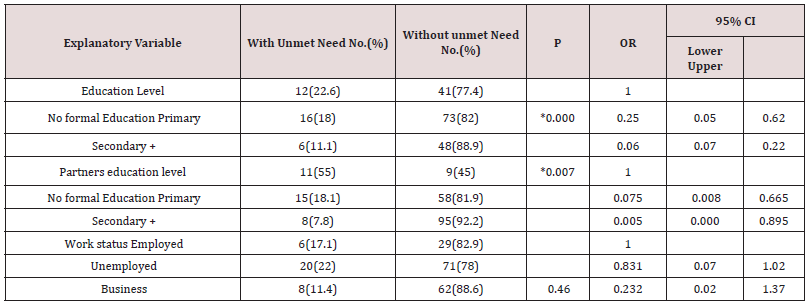
P-significant value; OR- odds Ratio; CI-Confidence interval.
*Significant P values.
Knowledge level on contraceptives among women of reproductive age in shebedino: The knowledge level of the respondents on both modern and traditional contraceptives was explored to capture their knowledge on various types and usage of contraceptives. A maximum of 20 knowledge items measured on a likert scale were used. These items covered knowledge within the scope on contraceptives mode of action, types, timing and their uses. Their scores were recorded and analyzed after grouping them. Every question answered correctly was awarded one mark and zero for those answered wrongly. Those who scored between 0 and 6 marks were regarded as having poor knowledge, between 7 and 13 as having moderate knowledge while 14 and above were regarded as having good knowledge on contraceptives. One of the questions the respondents were asked was to identify and list any contraceptives they knew[24-26]. The table above gives the distribution of scores. When the respondents were subjected to general questions on contraceptives to capture their knowledge level, 16.3% (n=32) had good knowledge, 40.8% (n=80) had moderate knowledge while a greater majority 42.9% (n=84) had poor knowledge on contraceptives as shown in Table 4. From the results it can be observed that there was significant association (p=0.035) between knowledge level and FP needs. The results thus indicate that the higher the knowledge level, the more likely that a respondent will have met need for FP. This result demonstrates the fact that improved knowledge on contraceptives increases the uptake of contraceptives.
Discussion
Unmet need for family planning: The study shows that the total unmet need for family planning among women living in shebedino was 17% at the time of the survey. This indicator of 17% among women of reproductive age is much lower than the current national unmet need for FP of 25.6% Unmet need for birth spacing and birth limiting nationally is 12.5% and 13.1% respectively while in the study was 12% and 5% respectively. This shows that there is a decrease in unmet need for birth limiting. This could be attributed to the increase in contraceptive use among limiters with no difference in contraceptive use behavior for the spacers in the study especially among 15-24 age groups. This is also observed in other studies among the low- income countries [27-30]. Generally, an increase in unmet need for FP in shebedino may be attributed to lack of knowledge on contraceptives, low level of education among women of reproductive age and poor maternal and child healthcare.
Demographic determinants of unmet need for FP among women living in shebedino: Age and experience of child loss were positively associated with the total unmet need for FP (p<0.05). This study shows a strong significant relationship between child loss and unmet need in that women who have an experience of child death have a high rate of unmet need for family planning (p=0.026). It is believed that when a child in a family dies, a woman becomes more anxious to replace the dead one leading to reluctancy in taking contraceptives and thus increase the rates of unmet need [31].The multivariate model results also indicate that women’s age shows a strong relationship and likelihood of having unmet need (P=0.008). It is about two and half times more likely for women with ages above 35years to have unmet needs as compared to those in the ages 15-24 years (OR=2.556) but less likely among women at ages between 25 to 34 years (OR=0.063). This implies that older women have more unmet need which might be attributed to lack of contraceptive uptake for limiting birth among this age group[32-35]. Young women do have unmet need probably due to lack of knowledge on contraceptives and the desire to have more children. Shrivastava also reported highest percentage of unmet needs for family planning in 15-19 years age group. Earlier studies had also revealed that the use of contraceptive measure was least among married women of similar age group[35-39].
Socio-Economic determinants of unmet need for FP among women living in shebedino: Partners’ education level and respondent education level were positively associated with the total unmet need for FP (p<0.05). [40] Studies elsewhere revealed same patterns of relationship where the level of education of the women and the maternal health services such as the uptake of family planning were positively associated. Women with primary education or no education at all were almost 2 times likely to experience unmet need for FP in comparison to post primary counterparts Wubegzier and Alemayehu [41]. Husband s’ education level was also associated with the unmet need for FP in this study implying that husband education is associated with the utilization of family planning services. Low level of education is believed and shown that it leads to little understanding on fertility, maternal and side effects of contraceptives.
Knowledge level on contraceptives and unmet need for FP. From the study, it was found that only 16.3% (n=32) had good knowledge, 40.8% (n=80) had moderate knowledge while a greater majority 42.9% (n=84) had poor knowledge on contraceptives as shown in Table 5. From the results in Table 5, it can be observed that there was a significant association (p=0.035) between knowledge level and unmet FP needs. Previous studies have shown that lack of sufficient knowledge on contraceptives and reproduction may contribute to almost two thirds of unmet need for family planning (Samira and Nihad [31]; Subhash [35]). Knowledge of specific contraceptive methods remains low, although knowledge of at least one method of contraception is high in the study population. Unmet need was found to be higher among those with poor contraceptive knowledge, 21.4% (n=18). This gives a clear indication that women with good knowledge on contraceptives are less likely to have unmet needs for FP. Poor knowledge on contraceptives may be an indication that the education level of both men and women in the area is low.
Table 5: Distribution of Knowledge level on contraceptives among women of reproductive age living in shebedino (n=196).

Conclusion
Ethiopia at the moment is experiencing a lot of pressure on its resources due to a tremendous increase in population growth especially in urban settlements. This has brought about a significant challenge for the country as more and more slums develop in major cities in Ethiopia. From this study, it is clear that the unmet need for family planning is still very high in shebedino and therefore there is urgent need for the government, non- governmental organizations and other stakeholders in reproductive health to act swiftly towards reducing the total fertility rate of its citizens. In the study it is clearly seen that the unmet need for FP is dominant among young. Mothers of between 15-24 years and fecund women of advanced ages and this makes age a factor of consideration during programmatic interventions. Experience of child loss and the region of residence also play an important role in the determination of women intention to use FP methods. Education level of the women and their spouses also determines their uptake of contraceptives according to the finding of the study.
Reference
- Abdel A andAmira (2013) Factors affecting unmet need for family planning in Eastern Sudan. BMC Public Health 13: pp.102.
- Andurkar S, Yadav V, and Dalvi S (2006) Study of unment need for family planning among married women of reproductive age in urban health central field practice area of Govt. Medical College, Aurangabad. Indian J Public Health 50: 45-46.
- Assefa, H, Fikrewold H (2011) Factors affecting unmet need for family planning in southernnations, nationalities and peoples region, Ethiopia. Ethiopean Journal of Health Sciences 21(2): 77-89.
- Bernstein S,andEduard L (2007) Targeting access to reproductive health: giving contraception more prominence and using indicator to monitor progress. Reproductive Health Matters 15(29): 186-191.
- Bradley K, Trevor N, Joy D, Westoff F (2012) Revising Unmet Need for Family Planning. DHS Analytical Studies No. 25(1). Calverton, Maryland, USA: ICF International.
- Ferdousi S, Jabbar M, Hoque S, Karim S, Mahmood A, Ara R, et al. (2010) Cochran W Sampling techniques (3rd) New York: John Wiley & Sons.
- (2010) Unmet need of family planning among Rural women in Bangladesh Dhaka Med Coll 19(1).
- Gebreselassie, T, and Pav G (2013) Levels and Trends in Unmet Need for Family Planning among Adolescents and Young Women in Ethiopia. Calverton, Maryland, USA: ICF International p.11-14.
- (2009) In Brief: Facts on Abortion in Kenya. New York: Guttmacher Institute.
- Igwegbe A, J Ugboaja, E Monago (2009) Prevalence and determinants of unmet need for family planning in Nnewi, South-east Nigeria. International Journal of Medicine and Medical Sciences 1(8): 325-329.
- Ipas (2009) Facts on Abortion in Kenya.
- Kamau K, Karanja J, Sekadde Kigondu C, Ruminjo K, Nichols D, et al.(1996) Barriers to contraceptive use in Kenya. East Afr Med J 73(10): 651-659.
- Kaushik S (1999) "Unmet Need for Family Planning: a Comparative Analysis of Northern and Southern States of India Based on NFHS data" Millennium Conference on Population, Development and Environment Nexus p.11-15.
- Macro (2003) Kenya Demographic and Health Survey Nairobi.
- Macro (2008) Kenya Demographic and Health Survey Nairobi.
- Macro (2010) Kenya Demographic Health Survey. Kenya National Bureau of Statistics and ICF.
- Khan S, S Bradley, J Fishel, V Mishra (2008) Unmet Need and the Demand for Family Planning in Uganda: Further Analysis of the Uganda Demographic and Health Surveys, 1995-2006. Calverton, MD: Macro International Inc.
- Kothari CR (2004) Research Methodology: Methods and Techniques (2nd Ed.). New Delhi: New Age International limited pp.152-154.
- Korra A (2002) Attitudes toward Family Planning, and Reasons for Nonuse among Women with Unmet Need for Family Planning in Ethiopia. Calverton, Maryland USA ORC Macro p.12-17.
- Laya KS (2012) Prevalance and determinants of unmet need for family planning among womenin India. Research and Social Practices in Social Sciences 7(2): 59-70.
- Ndaruhuye D, A Broekhuis, P Hooimeijer (2009) Demand and unmet need for means of family limitation in Rwanda. International Perspectives on Sexual and Reproductive Health 35(3):122-1230.
- NSEO (National Statistics & Evaluation Office [Eritrea]) & ORC Macro Inc (2003) Eritrea Demographic and Health Survey 2002. Calverto MD Macro International, Inc.
- Ojakaa D(2008) Trends and Determinants of Unmet Need for Family Planning in Kenya. DHS Working Papers No. 56 Calverton, MD: Macro International Inc :23-26.
- Okech T, Wawire N, Mburu K (2011) Contraceptive Use among Women of Reproductive Age in Kenya’s City Slums. International Journal of Business and Social Science 2(1):1-3.
- Oluwasanmi L, Supa P, Karl P (2011) Awareness and use of and barriers to family planning services among female university students in Lesotho. SAJOG 17(3): 1- 6.
- Omondi-Odhiambo (1997) “Men’s Participation in Decisions in Kenya.” Population Studies 51(1): 29-40.
- Omwago O, Khasakhala A (2006) “Factors influencing couples’ unmet need for contraception in Kenya”. Africa Population Studies 21(2): 75-94.
- Oyedokun O (2007) Determinants of Contraceptive Usage: Lessons from Women in Osun State, Nigeria. Journal of Humanities and Social Science 1(2): 1-3.
- Samira ME, Nihad KM (2011) Knowledge, attitude and practice of family planning among women in Basrah city south of Iraq. Medical journal Basrahh University 29(2): 1-3.
- Sedgh G, Hussain R, Bankole A, S Singh (2007) Occasional report No. 37.Women with an unmet need for contraception in developing countries and their reasons for not using a method New York, USA. Guttmacher Institute p. 5-9.
- Srivastava DK, Goutam P, Goutam R, Gour N, Bansal M (2011) A study to assess the unmet need of family planning in Gwalior Division and to study the factors that helps in determining it. National Journal of Community Medicine 2(1): 28-31.
- Subhash B (2013) Socio-economic and Demographic Determinants of Unmet Need for Family Planning in India and its Consequences. Research on Humanities and Social Sciences 3(3): 2-3.
- United Nations Population Fund (2010) Improving Reproductive Health, UNFPA, New York, viewed 23 April 2010.
- Westoff F (2006) New estimate of unmet need and the demand for family planning. DHS comparative reports No. 14. Calverton, Maryland, USA: Marco International Inc.
- Westoff CF, AR Cross (2006) The Stall in the Fertility Transition in Kenya, Measure/DHS.ORC Macro. United States Agency for International Development (USAID).
- World Health Organization (2010) unsafe abortion. Global and regional estimates of the incidence of unsafe abortion in 2008.Sixth edition. WHO, Department of Reproductive Health and Research, World Health Organization 2011.
- World Health Organisation (2012) Trends in Maternal Mortality 1990-2010. WHO, UNICEF, UNFPA and The World Bank Estimates.
- Wubegzier M. and Alemayehu W.(2011). Determinants of low family planning use and high unmet need in Butajira Division, South Central Ethiopia. Mekonnen and Worku Reproductive Health 8:37.

Top Editors
-

Mark E Smith
Bio chemistry
University of Texas Medical Branch, USA -

Lawrence A Presley
Department of Criminal Justice
Liberty University, USA -

Thomas W Miller
Department of Psychiatry
University of Kentucky, USA -

Gjumrakch Aliev
Department of Medicine
Gally International Biomedical Research & Consulting LLC, USA -

Christopher Bryant
Department of Urbanisation and Agricultural
Montreal university, USA -

Robert William Frare
Oral & Maxillofacial Pathology
New York University, USA -

Rudolph Modesto Navari
Gastroenterology and Hepatology
University of Alabama, UK -

Andrew Hague
Department of Medicine
Universities of Bradford, UK -

George Gregory Buttigieg
Maltese College of Obstetrics and Gynaecology, Europe -

Chen-Hsiung Yeh
Oncology
Circulogene Theranostics, England -
.png)
Emilio Bucio-Carrillo
Radiation Chemistry
National University of Mexico, USA -
.jpg)
Casey J Grenier
Analytical Chemistry
Wentworth Institute of Technology, USA -
Hany Atalah
Minimally Invasive Surgery
Mercer University school of Medicine, USA -

Abu-Hussein Muhamad
Pediatric Dentistry
University of Athens , Greece

The annual scholar awards from Lupine Publishers honor a selected number Read More...

.png)


